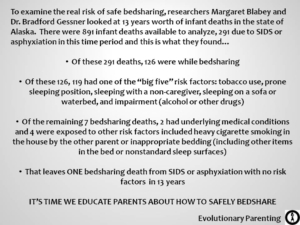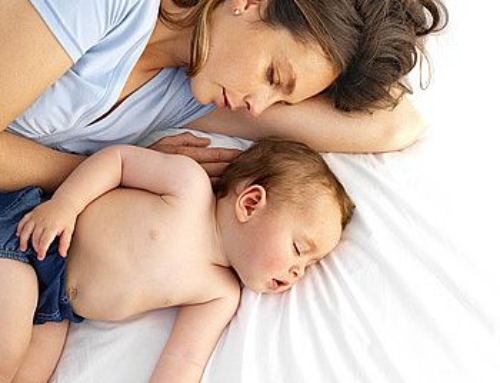If you mention “bedsharing” to many nurses or doctors or even other parents, they will often tell you exactly how dangerous it is. Haven’t you heard that it’s pretty much tantamount to trying to kill your child? I’ve had people comment on other pages they think parents should be charged for bedsharing. They really believe it’s that dangerous.
With last year’s Carpenter et al study[1] declaring a massive risk for bedsharing based on old data, Australian and New Zealand coroners calling for it to be illegal, and massive ad campaigns in the US trying to scare families away from it, it’s no wonder people have a rather frightful view of the matter. The problem is that, as far as we can tell, this is one of those cases where there’s more bark than bite.
In most of the research, children who died of SIDS or suffocation (often they are lumped together) are compared to “controls” and then we factor out known risk factors (known as a case-control study). This gives us an odds-ratio of the risk of any given activity while controlling for others. It’s dependent upon the control group you select and the questions asked. It’s immensely valuable, but also has, like all tests, it’s limitations. For example, in the Carpenter et al analysis, many variables were not assessed (e.g., the tog value of the bedding which is known to be a huge risk factor for infant overheating and SIDS) or assessed improperly (e.g., alcohol in one of the samples was assessed as having had a drink at all in the 24 hours previous thus a glass of wine at lunch put you as a “yes” and in that same study, drinking alcohol did not significantly interact with bedsharing as a risk factor… does that seem wrong to anyone else?).
Why can’t we just look at all the deaths and see the actual risks? Primarily because it’s a heck of a lot more work. I mean, an insane amount of work. You have to go through all autopsy and death records and hope that all of the details are there and accurately recorded. Many places don’t even have that kind of data so it’s just easier to do it the other way.
However, in Alaska, they recently decided to advise that bedsharing was an appropriate sleeping arrangement provided it was done safely, which they outlined as being with an unimpaired, non-smoking caregiver on a standard, adult, non-water mattress. This was in contrast to the campaigns and national recommendations being given in the rest of the USA. Because of this contrast, a member of the government and a medical doctor decided to do the real legwork and actually look at every single infant death on record for a period of 13 years to see the real risk of bedsharing[2]. It was made easier by the fact that Alaska has a committee that reviews all infant deaths which ensured the nitty gritty details were there for analysis. This is what they found…
- In Alaska between the years of 1992 and 2004 there were 939 deaths although only 891 had been through the review process of the Maternal-Infant Mortality Review and were available for analysis. Of these 891 deaths, 291 were SIDS or asphyxiation and were thus the deaths of interest for this research.
- Of the 291 SIDS and asphyxiation deaths, 246 had bedsharing information and 126 occurred while bedsharing.
- Of the 126 bedsharing SIDS/asphyxiation deaths, 119 had at least 1 “big five” risk factor which were defined as tobacco use, sleeping with a non-caregiver, prone sleep position (i.e., on baby’s stomach), impairment of bedsharing partner, and sofa or waterbed use. Of these, 39 had one risk factor, 44 had two risk factors, and 36 had more than two risk factors.
- Of the 7 remaining deaths, 2 had severe underlying medical illnesses and 4 had other risk factors including heavy smoke in the house by the non-bedsharing partner or multiple inappropriate items in the bed or sleeping on a nonstandard surface (non-sofa or waterbed).
If you can do your math, this leaves ONE infant death while bedsharing due to SIDS/asphyxiation in 13 years in the state of Alaska. ONE.
Now, I don’t know if situations in Alaska can be generalized to the rest of the US or other countries, but it seems to me that we might be barking up the wrong tree when it comes to the risks of bedsharing. Other research that has controlled for planned versus unplanned bedsharing found that when bedsharing was planned (likely leading to no risk factors), it was a non-significant risk (or no risk) compared to room-sharing[3].
It seems we should be educating people instead so that everyone can create a safe sleep environment for their children regardless of where that is.
For more information on how to bedshare safely, you can download this safe bedsharing pamphlet or read an article here.
For more information on bedsharing and SIDS, you can read this.
For a wonderful book on safe co-sleeping, please check out this one from Dr. James McKenna.
[1] Carpenter RG, McGarvey C, Mitchell EA, Tappin DM, Vennemann MM, et al. Bed sharing when parents do not smoke: is there a risk of SIDS? An individual level analysis of five major case-control studies. BMJ Open 2013; 3: e002299.
[2] Blabey MH, Gessner BD. Infant bed-sharing practices and associated risk factors among births and infant deaths in Alaska. Public Health Reports 2009; 124: 527-34.
[3] Vennemann MM, Bajanowski T, Brinkmann B, Jorch G, Sauerland C, Mitchell EA. Sleep environment risk factors for Sudden Infant Death Syndrome: the German Sudden Infant Death Syndrome study. Pediatrics 2009; 123: 1162-70.







I’m happy to hear about any and all bedsharing information, considering it is how my daughter and I’ve slept since her birth..I feel like it is a dirty secret that I hesitate to tell anyone in my life aside from my husband. I didn’t plan on doing it (the concept never crossed my mind, anyway) until she wore me out after multiple nights of terrible sleep and we fell asleep together. Since that night, we’ve made strides to make it as safe as possible, and with the failed attempts at letting her sleep in swings, reclining swings, vibrating chairs, rocking chairs, swaddled in a bassinet, not swaddled in a bassinet, with white noise, with recordings of heartbeats…well, we just went with what worked for us.
Your story is my story. Like, literally, you took the words right out of my mouth. People kept referring to other guttural parenting decisions as “trusting my gut.” But not this one. This one caused people, even people who love and support me, to be awkward and judgey. “Trust your gut, except for this, you child killer,” is what I felt like they were thinking. Anyway, we are super safe–to the point where I’m often times freezing cold and half my body is numb–but baby is 100% safe, and sleeping wonderfully!
Thanks once again for attempting to remove some of the stigma from bedsharing. We shared our bed with our daughter, now almost three, throughout her first two years. During that period I saw those super scary “information campaigns” that turned the headboard of a bed into a tombstone, but by that point she was old enough for me to not be that worried. My second child is now three months old, and he has slept next to me every night of his life, and every single one of those nights I have felt fear about our decision to bedshare (while also feeling like it is absolutely the only option for me to get any sleep). Every single one of those nights I have laid awake in bed next to him, worrying, hoping that he wakes up in the morning. I think obsessively about those campaigns that called adult beds babies’ “final resting places.” It has bored itself into my subconscious and no matter how much I try to make our sleeping space as safe as possible, I can’t shake the fear that the aggressive campaigns planted.
I empathize. But keep looking for information that validates it’s safety, because it is safe. And actually, biologically speaking, it is safer than a baby sleeping 8’hours in a crib down the hall.
Hi Tracy, thanks for posting this. Did that study have any data on method of feeding? I’ve read some research from Dr. James McKenna which suggested that babies who were breastfed were also less likely to die from SIDS/suffocation due to the mother instinctually positioning the baby differently (e.g., at breast height instead of at pillow height. He found babies who were never breast fed tended to be positioned higher in the bed and more likely to be near pillows, etc.) and would like to see how that number factored into the study. i.e. what % of the babies that died breastfed? Thanks – love your blog!
That actually makes perfect sense. I BF my baby and he sleeps at a lower position… And, this would be intentional even if I didn’t BF. We do all of the recommended safety guidelines for bed sharing.
On an international flight I was on a woman accidentally suffocated her infant when she feel asleep during breastfeeding. I use a cosleeper so that I can assure that my baby can be caressed while also being a safe distance from me. I know that I’m sleep deprived. I find the cosleeper to be a nice compromise. Even if one child dies from accidental suffocation during traditional bedsharing, in my mind, that is one too many and not worth the risk for my own baby.
What you describe on a plane ISN’T safe bedsharing. It’s exactly one of the ways in which we have seen more babies be put at risk when condemning bedsharing. That’s the problem: not providing real and accurate information is putting babies at greater risk. And it’s not about forcing people to do it, but to provide good, real info so you can make the decisions that work for you and your family.
Hope this is seen. But I sleep with my 3month old baby and he feeds during the night. Often while I’m not awake. I follow all of the safe seven rules (besides obviously no drinking nor smoking, nor meds, I have nothing on the bed and I sleep alone with him) but I’m not sure if him breastfeeding while I’m asleep is a risk for him?
It should be just fine – we all get to that stage and it’s a blissful one because it’s more sleep for you!!
Isn’t one baby dying in a cot one too many as well?
Sure, it would be except we have to compare it to the alternative action which is crib sleeping. How many babies died in cribs during the same time period?
As you can see, there were 291 SIDS or asphyxiation deaths and 126 were while bedsharing or use of sofa or other space like that. So there are 165 in cribs or playpens or car seats.
[…] On the other hand, if that video has left you scared and messed up your plans to co-sleep with your child, please read more on Evolutionary Parenting blog: do’s and don’ts or risks versus realities. […]
That’s my question too: How many babies died in cribs during the same time frame?
Based on the numbers – somewhere *around* 165 (though some may have been play pens or other areas infants commonly sleep in).
[…] To minimise risks when bed sharing, you’ll need a firm sleep surface, non smoking parents who are not under the influence of drugs or alcohol, a breast fed baby, no blankets or doonas etc near the baby’s head and more. Check out safe co-sleeping guidelines here and for more detailed information of bed sharing risk statistics and reporting checkout this article at evolutionary parenting. […]
[…] • https://gku.flm.mybluehost.me/evolutionaryparenting.com/bedsharing-risks-and-realities/ […]
[…] • Articles- https://gku.flm.mybluehost.me/evolutionaryparenting.com/bedsharing-risks-and-realities/ […]